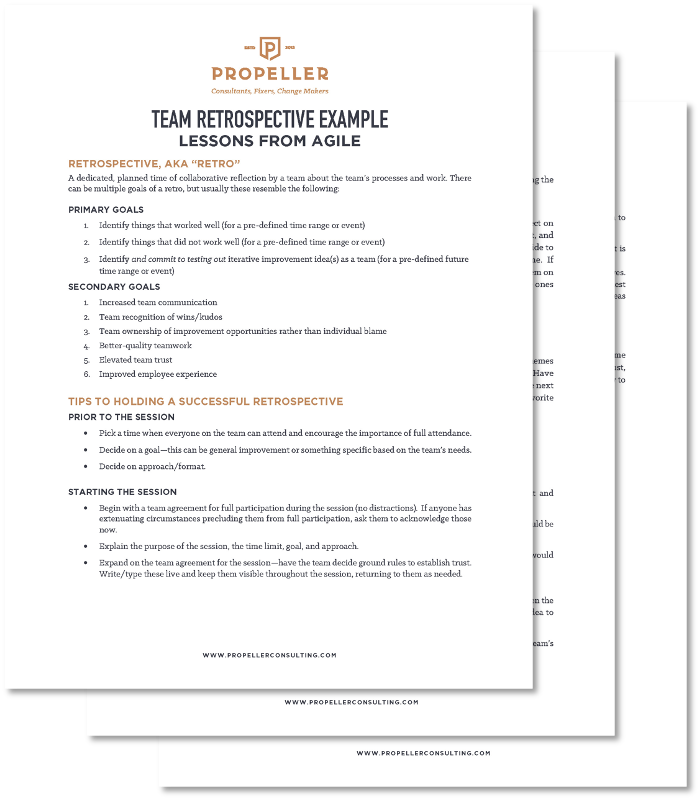A lot of us have started meeting with friends and family again, in person, to connect and tell our stories of the past 16 months. Recently, I spent a weekend hanging out with three good friends, in successive, face-to-face, and maskless meets. What a concept! These are friends I’ve been talking to virtually for more than a year, but it was the first time we’d been together socially and in person in a long time. After my third visit, I was struck by how healthy, human and important this storytelling is.
It’s rare that my personal life mimics my work life, but I suddenly realized a connection between my friend conversations and something I do with my Propeller clients. It’s an agile methodology exercise we call “a retrospective,” which is a fancy way of saying we stop, pause, and share our individual and collective stories. We do this exercise both during and after we start any organizational or technology transformation projects. With friends and clients both, pausing to tell our retrospective experiences creates new understanding and a sense of solidarity around what happened in order to arrive at what’s next.
Retrospective storytelling is part of the fabric of life. There is productive value for both our personal and professional lives. — Annie Lyons
Below, I’ve put my thoughts together on how the three parts of personal story sharing are very much like the retrospective storytelling we do with clients. There are a lot of connected dots.
Keep in mind that pausing to share is not always easy. Pausing for any reason is hard to do in this fast-moving world we live in. First, you’ll want to make sure you’re in a safe place for everyone to speak their mind freely and authentically. Next, you want to commit to the time to go as long as needed, with no rush or pressure (30-minute windows rarely feel effective). Finally, it’s important to trust that the process will get you to a place of alignment or decision and that accepting divergent views and ideas is part of the process of getting there.
Pauses are not always easy because you have to create the time and space. And yet, they are important because they may help you do the next chapter better. — Annie Lyons
# 1. The debrief
This is the initial burst of conversation where you recap an entire year: the highs, the lows, the easy, and the hard. The key to a good debrief is to let everyone share their narrative. It is their time to tell their story, their experience. In a good debrief, you are not there to solve, you are there to understand.
The debrief is sacred. It allows people to park their input and leave it there, to start building something new. — Annie Lyons
# 2. The retrospective and root cause analysis
From the debrief, there are common threads that emerge. These are the feelings and experiences we share. It’s at this juncture that we want to dig in and unpack the methods and tools needed to navigate the challenges. When we practice this approach together, we discover new ways of problem-solving, and, most importantly, we reconnect as a team around a shared understanding of the past.
Just like companies, people need to pause and tell their from-to story. Or listen to the from-to story. — Annie Lyons
# 3. The decision
At the close of a retrospective conversation is that moment when everyone exhales and decides, what now and what’s next? For a project team, this often looks something like what they’ll stop, start, or keep doing. With my social retrospectives, the closure looks very similar. Our priorities feel shifted, our perspectives are often changed, and we share newly formed plans to step into what’s next. For example, my friends and I started planning vacations! That counts.
I’m comfortable having this same debrief conversation over and over with friends because it’s part of our bigger shared experience—and that’s OK, it feels healthy. — Annie Lyons
# Celebrate where you’ve been. Purposefully establish where you’re going.
These conversational downloads are part of progressing and moving forward, whether it’s helping a client achieve their desired business outcome or a friend connect the dots about how the COVID experience helped them grow and change for the better. Maybe you’ve worked remotely with your team for a year and you’re now coming back together in a hybrid office environment. Sharing your collective experiences will help you reset as a team, which feels really good. You’ve come through a tough chapter together and solved some big issues as a team. That’s cause for a pause—stories—and a celebration. After that, you’ll likely find you have a new focus, new tools, new energy, and a shared sense of purpose.
Related Content: The COVID Vaccine Experience Through the Lens of 7 Business Consultants
Want to implement team retrospectives into your work or even personal life? Download the Team Retrospective Guide to help facilitate your next story-sharing session.





